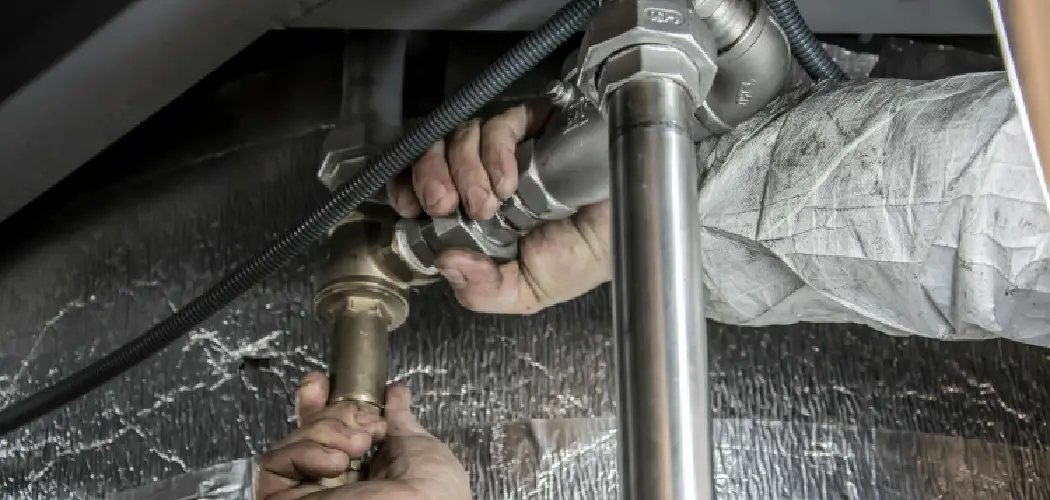To hide basement pipes, use decorative pipe covers or enclosures. Basement pipes can be an eyesore, disrupting the aesthetic appeal of your space.
Fortunately, there are several ways to hide them. One option is to use decorative pipe covers or enclosures. These covers are designed to seamlessly blend with your basement decor, concealing the unsightly pipes from view. Another option is to paint the pipes in a color that matches or complements your basement walls.
This helps them to blend in with the background, making them less noticeable. By disguising your basement pipes, you can create a cleaner and more visually appealing space.

Genius Solutions For Hiding Basement Pipes
When it comes to basement renovation, exposed pipes can ruin the aesthetic appeal of an otherwise beautifully finished space. Fortunately, there are genius solutions available to conceal those unsightly pipes and create a seamless look. In this article, we will explore three effective methods to hide basement pipes: enclosing pipes with removable panels, camouflaging pipes with faux finishes, and utilizing innovative storage solutions.
1. Enclosing Pipes With Removable Panels
One of the easiest and most practical ways to conceal basement pipes is by using removable panels. This method allows for easy access to the pipes when needed while maintaining a clean and polished appearance. To implement this solution, follow these steps:
- Measure the dimensions of the pipes you wish to enclose.
- Choose a durable and aesthetically pleasing material for the panels, such as wood or PVC.
- Cut the panels to the appropriate size using a saw or other cutting tool.
- Attach the panels to the walls or ceiling surrounding the pipes using screws or other secure fasteners.
- Ensure that the panels are securely in place and can be easily removed when necessary.
This method not only conceals the pipes but also provides an opportunity to add decorative elements to the panels, such as paint or wallpaper, to further enhance the visual appeal of your basement.
2. Camouflaging Pipes With Faux Finishes
If you prefer a more artistic approach to hide basement pipes, utilizing faux finishes can be a creative and effective solution. This technique involves painting the exposed pipes to blend seamlessly with the surrounding walls or ceiling. Follow these steps to achieve a cohesive look:
- Thoroughly clean the pipes to remove any dirt, dust, or grease.
- Apply a coat of primer designed for metal or PVC surfaces to ensure optimal paint adhesion.
- Select a color that matches or complements the surrounding area.
- Use a small paintbrush or roller to carefully apply the paint evenly onto the pipes.
- Allow the paint to dry completely before applying a second coat if necessary.
By camouflaging the pipes with faux finishes, you can transform them into an intentional design element that seamlessly integrates with the overall aesthetic of your basement.
3. Utilizing Innovative Storage Solutions
Another ingenious way to hide basement pipes is by incorporating innovative storage solutions. This method not only conceals the pipes but also maximizes the functionality of your basement. Consider the following storage ideas:
| Storage Idea | Description |
|---|---|
| 1. Built-in Shelving | Create custom-built shelves around the pipes to provide additional storage space for books, decorations, or other items. |
| 2. Cabinets or Cupboards | Install cabinets or cupboards beneath the pipes to hide them while gaining valuable storage space for tools, cleaning supplies, or seasonal items. |
| 3. Decorative Curtains | Hang decorative curtains in front of the pipes to add visual interest while disguising their presence. |
These innovative storage solutions not only hide basement pipes but also contribute to a more organized and functional space, allowing you to make the most of your basement area.
Frequently Asked Questions On How To Hide Basement Pipes
Q: How Can I Hide Basement Pipes Without Breaking The Bank?
A: There are cost-effective options to hide basement pipes, such as using decorative covers or painting them to match the wall color. Additionally, you can hide pipes behind curtains or install a false wall or ceiling to conceal them.
Q: What Are The Advantages Of Hiding Basement Pipes?
A: Hiding basement pipes not only improves the aesthetic appeal of the space but also eliminates the risk of accidental damage and makes it easier to maintain a clean and organized basement. It also provides a more finished look to the area.
Q: Are There Any Diy Methods To Conceal Basement Pipes?
A: Yes, there are several DIY methods to hide basement pipes. These include creating a built-in shelving unit or cabinet around the pipes, using fabric or wallpaper to create a pipe cover, or installing a removable panel or screen to conceal the pipes when necessary.
Q: Can I Paint Basement Pipes To Make Them Less Noticeable?
A: Yes, painting the basement pipes can be an effective way to make them blend in with the surrounding walls. Using the same color as the wall or opting for a camouflage technique can help to minimize the visibility of the pipes.
Conclusion
Concealing basement pipes doesn’t need to be a challenging task. By using the strategies discussed you can transform your basement into a more visually appealing and functional space. Whether you choose to cover the pipes with decorative options or incorporate them into the overall design, you can create a seamless and attractive environment.
Remember to prioritize safety and consult professionals if needed for a successful outcome.

